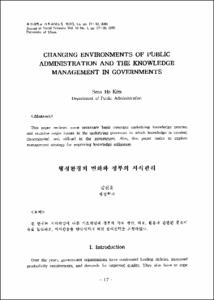A Study of English Consonant Clusters
- Alternative Title
- 英語子音群의 硏究
- Abstract
- 한 음절 속에 두 개 또는 그 이상의 자음이 연결되어 있는 것을 자음군(Consonant Cluster)이라고 한다. 자음군은 어두자음군과 어미자음군으로 크게 나누어지는데 영어에는 이와 같은 자음군들이 상당히 많이있다.
먼저 영어의 음절 구조를 살펴보면 CCCVCCCC의 경우처럼 핵음(Syllable Nucleus)을 중심으로 각각 앞에 3개 뒤에는 심지어 4개의 자음이 오는 것을 알 수 있다. 이와 같이 한 음절에서 모음 앞에 여러 형태의 자음이 잇달아 오는 경우에 어두자음군이 형성되는데 영어에는 이런 형태가 43개나 있다고 생각된다.
특히 어미 자음군에서는 -s, -ed등 굴절 어미의 추가로 그 숫자가 급증하는데 Prator, Jr,는 약 175가 지의 예를 제사하고 있다. 이러한 사실은 결과적으로 이들 자음의 연속 관계를 가지고 있지 않은 나라의 사람들에게는 영어 발음에 큰 어려움이 아닐 수 없다.
또한 어중 자음군이라던가 언어의 흐름 속에서 미자음군과 두자음군이 만나는 말의 경우에도 문제가 된다. 영어 학습자들은 자국어의 습관에서 곧잘 이들 자음군 사이에 불필요한 모음을 삽입시킴으로써 (예:한음절인 'street'의 발음에 있어/ si-ti-ri-ti/와 같이 4음절로 발음한다) 부자연스런 발음을 하게 되는데 이는 영어를 모국어로 하는 사람들의 말을 자세히 들어보면 자음군 사시에 모음이 끼어 들지 못하도록 곧바로 빠르게 발음하는 것을 알 수 있다.
영어인들까지도 영어의 자음군의 발음에 대한 간소화를 추구한다. 때때로 이들 자음군의 간소화는 어려움을 덜어 줄 수가 있다. 가령 'glimpsed'에서 엄 자음군 /-mpst/는 때로 /-mst/로 ?像실玖? 편하다. 물론 이의 지나친 사용은 역시 부자연스런 발음이 된다는 것에 유의해야 한다.
아뭏든 영어 발음에 있어서 커다란 부분을 차지하고 있는 이를 자음군의 발음을 회피할 수는 없으므로 영어 학습자들은 자음의 분포 상황의 분석을 통해 가장 빈도수가 많은 것들을 찾아내서 꾸준히 연습한다면 이러한 자음군의 발음에 보다 용이하게 익숙해 질 수 있을 것이다.
We can see the sequences of two or more consonants within one syllable in the English language. Such sequences of consonants are called consonant cluster. English has a great inventory of consonant clusters. Unlike many languages, English permits from one to three consonants n the initial position, whereas more consonant clusters occur in the final position because of the addition of -s or -ed endings. Prator, Jr. shows 43 initial and about 175 final consonant clusters, which are especially troublesome for most speakers whose native language does not have such complex syllables.
Furthermore, they also have difficulty in the medial position or when words with final consonant clusters precede in the stream of speech words beginning with initial clusters. It is therefore easy for new speakers to make an error of inserting a vowel between them. For example, they tend to pronounce the one syllable word 'street' as four syllables /si-ti-ri-ti/. A careful listener, however, can notice that the native speakers pronounce them quickly and directly in order that no finishing sound may creep in.
Sometimes even native speakers of English try to find way to simplify these consonant cluster. Take the word 'glimpsed' for instance; glimpsed /-mpst/ becomes /-mst/. Notice that too much use of the simplification may result in unnatural pronunciation.
In any case, new speakers of english will be easily accustomed to the pronunciation of the consonant clusters if they make exhaustive researches and practise repeatedly on them because there is no way avoid pronouncing these consonant clusters which are an essential part of the sound system of English.
We can see the sequences of two or more consonants within one syllable in the English language. Such sequences of consonants are called consonant cluster. English has a great inventory of consonant clusters. Unlike many languages, English permits from one to three consonants n the initial position, whereas more consonant clusters occur in the final position because of the addition of -s or -ed endings. Prator, Jr. shows 43 initial and about 175 final consonant clusters, which are especially troublesome for most speakers whose native language does not have such complex syllables.
Furthermore, they also have difficulty in the medial position or when words with final consonant clusters precede in the stream of speech words beginning with initial clusters. It is therefore easy for new speakers to make an error of inserting a vowel between them. For example, they tend to pronounce the one syllable word 'street' as four syllables /si-ti-ri-ti/. A careful listener, however, can notice that the native speakers pronounce them quickly and directly in order that no finishing sound may creep in.
Sometimes even native speakers of English try to find way to simplify these consonant cluster. Take the word 'glimpsed' for instance; glimpsed /-mpst/ becomes /-mst/. Notice that too much use of the simplification may result in unnatural pronunciation.
In any case, new speakers of english will be easily accustomed to the pronunciation of the consonant clusters if they make exhaustive researches and practise repeatedly on them because there is no way avoid pronouncing these consonant clusters which are an essential part of the sound system of English.
- Issued Date
- 1980
- Type
- Research Laboratory
- Alternative Author(s)
- 류성렬
- Publisher
- 연구논문집
- Language
- eng
- Rights
- 울산대학교 저작물은 저작권에 의해 보호받습니다.
- Citation Volume
- 11
- Citation Number
- 1
- Citation Start Page
- 147
- Citation End Page
- 156
- Appears in Collections:
- Research Laboratory > University of Ulsan Report
- 파일 목록
-
-
Download
 000002025254.pdf
기타 데이터 / 1.18 MB / Adobe PDF
000002025254.pdf
기타 데이터 / 1.18 MB / Adobe PDF
-
Items in Repository are protected by copyright, with all rights reserved, unless otherwise indicated.